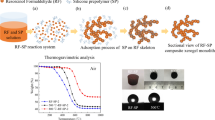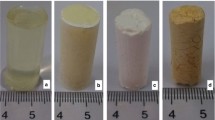Abstract
Thermal insulating materials are of importance for efficient and effective use of heat energy. Porous organic foams are widely employed for this purpose owing to their low thermal conductivity and mass productivity at low cost. However, the poor thermal stability of organic polymers limits their availability within a low temperature range (typically, < 150 °C). In this paper, we demonstrate the one-pot sol–gel synthesis of porous poly(amic acid) (PAA) xerogels and their conversion to porous polyimide (PI) monoliths by thermal imidization. The PAA networks crosslinked with either aromatic or aliphatic triamine and the bicontinuous porous morphology tailored via spinodal decomposition allow the evaporative drying at ambient pressure to obtain low-density PAA xerogels without significant shrinkage. The aromatic crosslinker yields the porous PI monoliths with higher porosity and flexible feature as compared with those prepared with the aliphatic triamine. On the other hand, the porous PI monolith based on the aliphatic crosslinker possesses slightly higher thermal stability owing to the stiffer mechanical property. The durability test results verify the porous PI thermal insulators are available in air at up to ~450 °C for a short period and up to ~350 °C for a long term.

Graphical abstract
Highlights
-
Porous poly(amic acid) xerogels with bicontinuous morphology are fabricated via the phase separation method.
-
Crosslinked polymer networks are synthesized by using either aromatic or aliphatic triamine crosslinker.
-
Porous polyimide monoliths prepared with the aromatic crosslinker show the lower shrinkage during thermal imidization.
-
The polyimide network crosslinked with the aliphatic triamine exhibits the higher thermal stability against shrinkage.
-
The long-term durability test reveals the availability of the polyimide thermal insulators at up to 350 °C in air.








Similar content being viewed by others
References
Fricke J (1988) Aerogels – highly tenuous solids with fascinating properties. J Non-Cryst Solids 100:169–173. https://doi.org/10.1016/0022-3093(88)90014-2
Hüsing N, Schubert U (1998) Aerogels – airy materials: Chemistry, structure, and properties. Angew Chem Int Ed 37:22–45. https://doi.org/10.1002/(SICI)1521-3773(19980202)37:1/2<22::AID-ANIE22>3.0.CO;2-I
Lemmon EW, Jacobsen RT (2004) Viscosity and thermal conductivity equations for nitrogen, oxygen, argon, and air. Int J Thermophys 25:21–68. https://doi.org/10.1023/B:IJOT.0000022327.04529.f3
Hayase G, Kugimiya K, Ogawa M, Kodera Y, Kanamori K, Nakanishi K (2014) The thermal conductivity of polymethylsilsesquioxane aerogels and xerogels with varied pore size for practical application to thermal superinsulators. J Mater Chem A 2:6525–6531. https://doi.org/10.1039/C3TA15094A
Lu X, Arduini-Schuster MC, Kuhn J, Nilsson O, Fricke J, Pekala RW (1992) Thermal conductivity of monolithic organic aerogels. Science 255:971–972. https://doi.org/10.1126/science.255.5047.971
Sroog CE, Endrey AL, Abramo SV, Berr CE, Edwards WM, Olivier KL (1965) Aromatic polypyromellitimides from aromatic polyamic acids. J Polym Sci: Part A 3:1373–1390. https://doi.org/10.1002/pol.1965.100030410
Liaw DJ, Wang KL, Huang YC, Lee KR, Lai JY, Ha CS (2012) Advanced polyimide materials: syntheses, physical properties and applications. Prog Polym Sci 37:907–974. https://doi.org/10.1016/j.progpolymsci.2012.02.005
Fang J, Kita H, Okamoto K (2000) Hyperbranched polyimides for gas separation applications. 1. Synthesis and characterization. Macromolecules 33:4639–4646. https://doi.org/10.1021/ma9921293
He J, Horie K, Yokota R, He F (2001) Preparation of end-crosslinked polyimide gels with high moduli. Polymer 42:4063–4072. https://doi.org/10.1016/S0032-3861(00)00803-X
Kawaguchi K, Saito H, Furukawa H, Horie K (2007) Superior nanoporous polyimides via supercritical CO2 drying of jungle-gym-type polyimide gels. Macromol Rapid Commun 28:96–100. https://doi.org/10.1002/marc.200600587
Chidambareswarapattar C, Larimore Z, Sotiriou-Leventis C, Mang JT, Leventis N (2010) One-step room-temperature synthesis of fibrous polyimide aerogels from anhydrides and isocyanates and conversion to isomorphic carbons. J Mater Chem 20:9666–9678. https://doi.org/10.1039/C0JM01844A
Leventis N, Sotiriou-Leventis C, Mohite DP, Larimore ZJ, Mang JT, Churu G, Lu H (2011) Polyimide aerogels by ring-opening metathesis polymerization (ROMP). Chem Mater 23:2250–2261. https://doi.org/10.1021/cm200323e
Guo H, Meador MAB, McCorkle L, Quade DJ, Guo J, Hamilton B, Cakmak M, Sprowl G (2011) Polyimide aerogels cross-linked through amine functionalized polyoligomeric silsesquioxane. ACS Appl Mater Interfaces 3:546–552. https://doi.org/10.1021/am101123h
Guo H, Meador MAB, McCorkle, Quade DJ, Guo J, Hamilton B, Cakmak M (2012) Tailoring properties of cross-linked polyimide aerogels for better Moisture resistance, flexibility, and strength. ACS Appl Mater Interfaces 4:5422–5429. https://doi.org/10.1021/am301347a
Chidambareswarapattar C, Xu L, Sotiriou-Leventis C, Leventis N (2013) Robust monolithic multiscale nanoporous polyimides and conversion to isomorphic carbons. RSC Adv 3:26459–26469. https://doi.org/10.1039/C3RA43717E
Pei X, Zhai W, Zheng W (2014) Preparation and characterization of highly cross-linked polyimide aerogels based on polyimide containing trimethoxysilane side groups. Langmuir 30:13375–13383. https://doi.org/10.1021/la5026735
Meador MAB, Alemán CR, Hanson K, Ramirez N, Vivod SL, Wilmoth N, McCorkle L (2015) Polyimide aerogels with amide cross-links: A low cost alternative for mechanically strong polymer aerogels. ACS Appl Mater Interfaces 7:1240–1249. https://doi.org/10.1021/am507268c
Nguyen BN, Cudjoe E, Douglas A, Scheiman D, McCorkle L, Meador MAB, Rowan SJ (2016) Polyimide cellulose nanocrystal composite aerogels. Macromolecules 46:1692–1703. https://doi.org/10.1021/acs.macromol.5b01573
Feng J, Wang X, Jiang Y, Du D, Feng J (2016) Study on thermal conductivities of aromatic polyimide aerogels. ACS Appl Mater Interfaces 8:12992–12996. https://doi.org/10.1021/acsami.6b02183
Viggiano RP, Williams JC, Schiraldi DA, Meador MAB (2017) Effect of bulky substituents in the polymer backbone on the properties of polyimide aerogels. ACS Appl Mater Interfaces 8:12992–12996. https://doi.org/10.1021/acsami.6b15440
Nguyen BN, Meador MAB, Sheiman D, McCorkle (2017) Polyimide aerogels using triisocyanate as cross-linker. ACS Appl Mater Interfaces 9:27313–27321. https://doi.org/10.1021/acsami.7b07821
Zhai C, Jana SC (2017) Tuning porous networks in polyimide aerogels for airborne nanoparticle filtration. ACS Appl Mater Interfaces 9:27313–27321. https://doi.org/10.1021/acsami.7b09345
Teo N, Jana SC (2018) Solvent effects on tuning pore structures in polyimide aerogels. Langmuir 34:8581–8590. https://doi.org/10.1021/acs.langmuir.8b01513
Teo N, Gu Z, Jana SC (2018) Polyimide-based aerogel foams, via emulsion-templating. Polymer 157:95–102. https://doi.org/10.1016/j.polymer.2018.10.030
Fan W, Zhang X, Zhang Y, Zhang Y, Liu T (2019) Lightweight, strong, and super-thermal insulating polyimide composite aerogels under high temperature. Comp Sci Technol 173:47–52. https://doi.org/10.1016/j.compscitech.2019.01.025
Koebel M, Rigacci A, Achard P (2012) J Sol–Gel Sci Technol 63:315–339. https://doi.org/10.1007/s10971-012-2792-9
Cuce E, Cuce PM, Wood CJ, Riffat SB (2014) Toward aerogel based thermal superinsultion in buildings: A comprehensive review. Renew Sus Energy Rev 34:273–299. https://doi.org/10.1016/j.rser.2014.03.017
Itatani H (2007) Crosslinked polyimide, composition comprising the same and method for producing the same. US Patent No. US20070106056.
Hasegawa G, Shimizu T, Kanamori K, Maeno A, Kaji H, Nakanishi K (2017) Highly flexible hybrid polymer aerogels and xerogels based on resorcinol-formaldehyde with enhanced elastic stiffness and recoverability: Insights into the origin of their mechanical properties. Chem Mater 29:2122–2134. https://doi.org/10.1021/acs.chemmater.6b04706
Kanamori K, Nakanishi K, Hanada T (2006) Rigid macroporous poly(divinylbenzene) monoliths with a well-defined bicontinuous morphology prepared by living radical polymerization. Adv Mater 18:2407–2411. https://doi.org/10.1002/adma.200601026
Kanamori K, Hasegawa J, Nakanishi K, Hanada T (2008) Facile synthesis of macroporous crosslinked methacrylate gels by atom transfer radical polymerization. Macromolecules 41:7186–7193. https://doi.org/10.1021/ma800563p
Hasegawa J, Kanamori K, Nakanishi K, Hanada T, Yamago S (2009) Pore formation in poly(divinylbenzene) networks derived from organotellurium-mediated living radical polymerization. Macromolecules 42:1270–1277. https://doi.org/10.1021/ma802343a
Hasegawa J, Kanamori K, Nakanishi K, Hanada T, Yamago S (2009) Rigid cross-linked polyacrylamide monoliths with well-defined macropores synthesized by living polymerization. Macromol Rapid Commun 30:986–990. https://doi.org/10.1002/marc.200900066
Hasegawa G, Kanamori K, Nakanishi K, Yamago S (2011) Fabrication of highly crosslinked methacrylate-based polymer monoliths with well-defined macropores via living radical polymerization. Polymer 52:4644–4647. https://doi.org/10.1016/j.polymer.2011.08.028
Hasegawa G, Kanamori K, Ishizuka N, Nakanishi K (2012) New monolithic capillary columns with well-defined macropores based on poly(styrene-co-divinylbenzene). ACS Appl Mater Interfaces 4:2343–2347. https://doi.org/10.1021/am300552q
Dine-Hart RA, Wright WW (1967) Preparation and fabrication of aromatic polyimides. J Appl Polym Sci 11:609–627. https://doi.org/10.1002/app.1967.070110501
Koton MM, Meleshko TK, Kudryavtsev VV, Nechayev PP, Kamzolkina YV, Bogorad NN (1982) Investigation of the kinetics of chemical imidization. Polym Sci USSR 24:791–800. https://doi.org/10.1016/0032-3950(82)90334-3
Kailani M, Sung CSP (1998) Chemical imidization study by spectroscopic techniques. 2. Polyamic acids. Macromolecules 31:5779–5874. https://doi.org/10.1021/ma9800966
Shin TJ, Ree M (2007) Thermal imidization and structural evolution of thin films of poly(4,4’-oxydiphenylene p-pyromellitamic diethyl ester). J Phys Chem B 111:13894–13900. https://doi.org/10.1021/jp075067o
Ishida H, Wellinghoff ST, Baer E, Koenig JL (1980) Spectroscopic studies of Poly[N,N’-bis(phenoxyphenyl)pyromellitimide]. 1. Structures of the polyimide and three model compounds Macromolecules 13:826–834 https://doi.org/10.1021/ma60076a011
Zhang S, Li Y, Yin D, Wang X, Zhao X, Shao Y, Yang S (2005) Study on synthesis and characterization of novel polyimides derived from 2,6-bis(3-aminobenzoyl) pyridine. Eur Polym J 41:1097–1107. https://doi.org/10.1016/j.eurpolymj.2004.11.014
Kazaryan LG, Tsvankin DY, Ginzburg BM, Tuichiev S, Korzhavin LN, Frenkel SY (1972) X-ray diffraction study of the crystalline structure of aromatic polyimides. Polym Sci USSR 14:1344–1354. https://doi.org/10.1016/0032-3950(72)90183-9
Takahashi N, Yoon DY, Parrish W (1984) Molecular order in condensed states of semiflexible poly(amic acid) and polyimide. Macromolecules 17:2583–2588. https://doi.org/10.1021/ma00142a021
Factor BJ, Russell TP, Toney MF (1991) Surface-induced ordering of an aromatic polyimide. Phys Rev Lett 66:1181–1184. https://doi.org/10.1103/PhysRevLett.66.1181
Factor BJ, Russell TP, Toney MF (1993) Grazing incidence X-ray scattering studies of thin films of an aromatic polyimide. Macromolecules 26:2847–2859. https://doi.org/10.1021/ma00063a033
Ojeda JR, Mobley J, Martin DC (1995) Physical and chemical evolution of PMDA-ODA during thermal imidization. J Polym Sci: Part B 32:559–569. https://doi.org/10.1002/polb.1995.090330404
Acknowledgements
This work was supported by the Asahi Glass Foundation. Financial supports from Japan Science and Technology Agency (JST) FOREST Program (Grant Number JPMJFR2021, Japan) is also acknowledged.
Author contributions
MI and YS contributed equally to the sample preparation and the data collection. HA, KH and KK took part in discussion on the data analyses. GH designed the study, collected the data and wrote the first draft of this manuscript. All authors read and approved the final manuscript.
Author information
Authors and Affiliations
Corresponding author
Ethics declarations
Conflict of interest
The authors declare no competing interests.
Additional information
Publisher’s note Springer Nature remains neutral with regard to jurisdictional claims in published maps and institutional affiliations.
Supplementary information
Rights and permissions
About this article
Cite this article
Ishida, M., Sashiyama, Y., Akamatsu, H. et al. Mechanical and thermal properties of porous polyimide monoliths crosslinked with aromatic and aliphatic triamines. J Sol-Gel Sci Technol 104, 526–535 (2022). https://doi.org/10.1007/s10971-022-05843-8
Received:
Accepted:
Published:
Issue Date:
DOI: https://doi.org/10.1007/s10971-022-05843-8




